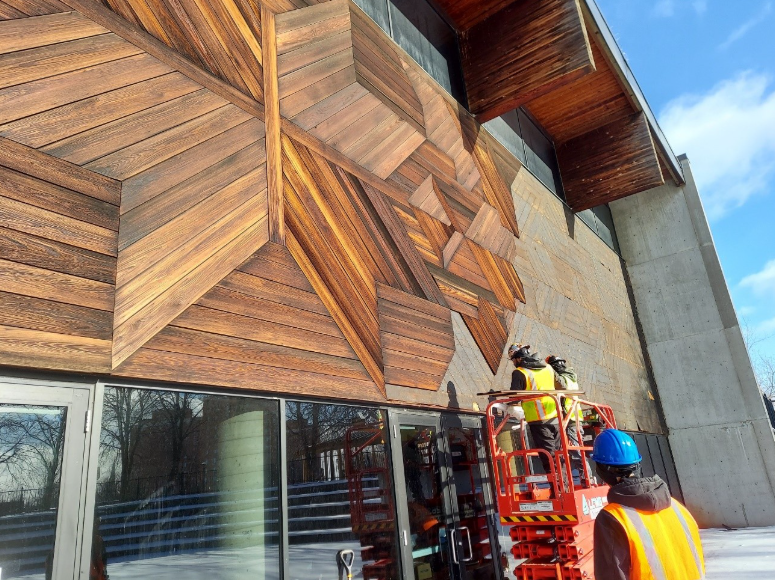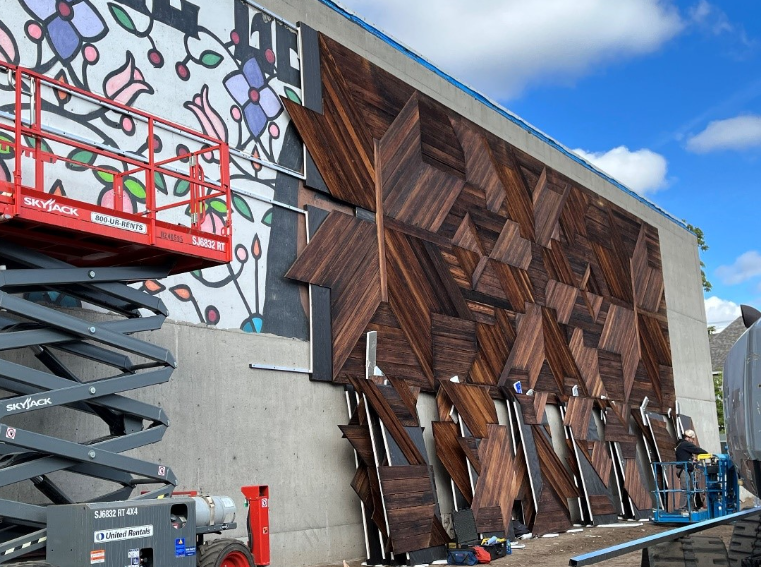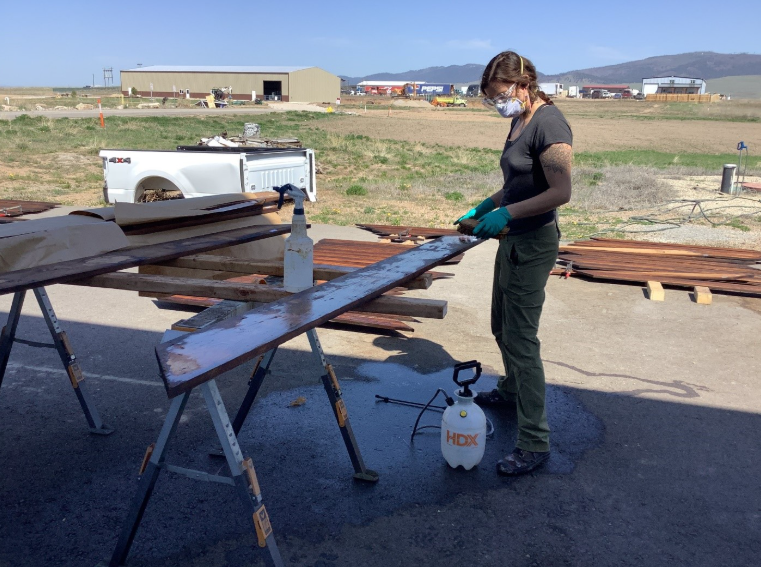George Morrison’s Turning the Feather Around.’ A mural for the Indian has been a staple feature of the Minneapolis American Indian Center (MAIC) for 50 years. As such, it has been a work of great care to ensure the façade can be restored and repositioned to continue to be part MAIC landscape.
Two Rivers Gallery sat down with Josie Hoffman (she/they) (Grand Portage Anishinaabe), one of the fellows selected to work with the Midwest Art Conservation Center (MACC) on the conservation of George Morrison’s Turning the Feather Around.’ A mural for the Indian, to talk more about what this project means for the center and the Twin Cities urban Indigenous community, the importance of working with other Indigenous people on the project, and about Josie’s art and other endeavors.
“I’m an artist,” Josie said. “I graduated from Minneapolis College of Art and Design in 2020, and [I’ve] been doing a variety of projects, from teaching aerial arts and working with the Native Youth Arts Collective at Little Earth and doing my own art projects. I got into this conservation project in 2022, and I just finished a curatorial project with Minneapolis Institute of Art (MIA).”
Two Rivers Gallery: Tell us a little bit about that project at the Minneapolis Institute of Art.
“I curated a case in the Native galleries that has two George Morrisons in it. The theme is about dance and kinetic movement and how that connects to our community and the land around us. And so, I had selected pieces; there is a bandolier bag, some leggings, two George Morrisons, a Wendy Redstar dress, and Alex Janvier, a Diné artist,” she said about the exhibit, which took place last year.
To learn more about Josie’s thoughts behind the installation, check out this interview with MIA news.
Josie has found inspiration in movement and dance. They site their interest when talking about work she did when finishing school at the Minneapolis College of Art and Design (MCAD). She’s transitioned in and out of different mediums during her career.
“I was a fine arts student and got my minor as a teaching artist. I’ve always done a lot of mixed media stuff. I focused a lot on sculpture and mixed media 2D things. I do a lot of materials; in school I was really into working, especially when it came to sculpture, with welding and doing plaster and ceramics stuff,” she said. “Now that I’m graduated, I’ve been focusing on my textiles and getting better at sewing and beading. I’m also a dancer so I want to make stuff.”
Two Rivers Gallery: What was your final school project?
“Because I graduated in 2021, we didn’t get a real show, but I had the whole thing planned. It was the study in movement that I was doing because I grew up a powwow dancer, and I also have been doing aerial arts,” Josie said.
Josie teaches aerial arts in multiple locations around Minneapolis. “So aerial arts are a big part of my practice, like aerial acrobatics. It’s just a study in movement that is a part of my life. I was learning those things and playing with video and images of me in these different types of movements. And now it’s evolved into performance, and I have a choreographed piece where I’m dancing using the aerial apparatus to powwow music,” they explain. “I want to keep doing this because I want to practice my crow hop. In aerial we have these things called ‘beats’ where we swing back and forth. Because of a shoulder injury I had to be specific with how I did it. My shoulder is getting better so I can land those beats that are a little different in the fabric.”
For more images from Josie, visit her website.
The conservation project of the George Morrison mural was divided into three main phrases consisting of the deinstallation, a cleaning in Montana, and the re-installation in the façade’s new location on the eastern wall of the Minneapolis American Indian Center.
Two Rivers Gallery: How were you involved with the George Morrison mural project?
“Yeah, so there was the deinstallation and then when we went to Montana to work with the brickers and do the treating and the cleaning of [the wood pieces] and then re-installation. Then there was a lot of documentation and other stuff to keep it all catalogued, you know. Cataloguing and documenting each piece because it’s over 700 boards and we’re keeping track of the orientation of them and documenting any splits or anything that might have been in there. Fix the splits. So yeah, it was fun, tedious work.” They end with a laugh.
Two Rivers Gallery: Where there any surprises for you or the team going into the project?
“No, I was pretty much coming into it as a learning experience, I’d never done a conservation project like this or worked with conservators in general. So, this was all a learning experience for me, but it was cool to learn all the research they had to do just to figure out the solution for what to clean it with. Because we didn’t want to strip the board completely or repaint them. Because that was part of George’s vision too. It was interesting to hear the science about it. I don’t have a science brain, I have an artist brain, so it was cool to hear about that and the reasons why they chose that solution. So, it was all a learning experience.”
She goes on to explain that the process in Montana took about two weeks, but they only were there for the first part of the process. There Josie was able to learn more about the cleaning solution that would help prevent mold without stripping the mural of the patina and natural color that was part of George Morrison’s vision for the artwork. Talking about how it looks all clean in its new location, Two Rivers Gallery Arts Consultant Lydia Four Horns levels, “I’m a little sad it’s on the other side of the building, but it’s so beautiful now! It looks more bronze now and it’s so gorgeous.” Josie nods in agreement and adds, “The way the sun hits it, it’s just like, ‘there it is!’”
Two Rivers Gallery: Is this your first conservation project?
“It is, so it was like a really great learning opportunity. Like I said, I went to art school, and I’ve just been interested in being in the arts and figuring out my career path. Right now, I’m just like doing all these projects and I love it. Maybe that’s what I’ll just keep doing but I’m interested in caring for our community’s artwork. I’m going down this curatorial path and I want to show off all these cool artists in our community. And so, it felt really special to be a part of the George Morrison piece on a personal level.”
Two Rivers Gallery: Were you inspired by George?
“I’ve been inspired by George’s work for a while, even before this project so it was exciting for me just to be able to work on this. But, especially during my schooling, I would read about George all the time.”
Josie reminisces on her family’s connection to Morrison. “George Morrison was a mentor to my mom, and my grandma knew him too; in their later years, my grandma and him were spending time together.” Originally from near the border of North Dakota in the twin town Breckenridge-Wahpeton, her maternal family is Grand Portage Ojibwe. “And then, I was asking my mom to tell me stories about when she studied under him. I was really fascinated.”
Two Rivers Gallery: From an arts perspective, what were you thinking about [on this project]?
They immediately think back on the second phase of the project and all the wooden boards that make up the mural. “I loved cleaning them,” she states. “Cleaning the boards because each individual board was beautiful in its own way. And I was like ‘this is just insane’ being up close to it and seeing the fine detail of each board that is going to be part of something that’s so much bigger. That’s just one specific thing that I really enjoyed. My art side was just like ‘whoa’.”
Josie continues speaking about the people she learned from and collaborated with. “It was cool working with the riggers too. And how they were thinking about putting this piece back together. Before they were all on the same backing, so what the riggers did was basically make these puzzle pieces for the backing so they kind of Tetris’d back in when we put them back up,” they explain. “It was really cool seeing their way of putting the pieces together and how they laid it out. Just watching the riggers do that was a cool learning experience. Just to see how they’re thinking about that too.”
Two Rivers Gallery: What does it mean to you to work with other Natives on this project or other museum work you’ve done?
“I was happy to have other Natives around. Being within institutions can often feel uncomfortable in ways, when its predominantly white folks running these institutions and the historical facts of these institutions; sometimes it can just feel uncomfortable as a Native person. And it’s really good to have these learning experiences within these institutions. I feel like I’m learning a lot with this work. It was nice to have other Native people around for support. And again, on that personal level, this felt special with George being from my same tribal community and being able to care for this piece for him, for our tribe, and for the community here in Minneapolis.”
Lydia adds, “I think it’s just incredible that we were able to connect with someone who actually has some ancestral connection to the artist. I’m more than thrilled to be able to nurture that relationship more. When this project came up, I thought that it was imperative that part of our work with MACC include training other Native people who are new to the field or have an interest [in conservation].”
Two Rivers Gallery: Did you get a lot of community interaction while you were out there?
“When we were reinstalling, community members would come up to the fence and ask what we were doing. Being able to talk to them about the Morrison mural was really fun.”
Two Rivers Gallery curatorial assistant, Sydney Ockenga joins in, “Deinstall was so fast. I remember seeing you out there and only a couple others watching periodically then.” “And during that major [winter] storm too!” Lydia adds.



